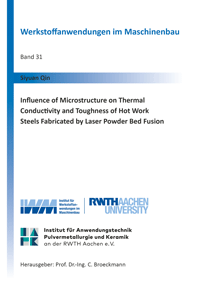
Shop : Details
Shop
Details
58,80 €ISBN 978-3-8440-9656-9Softcover164 pages87 figures218 g21 x 14,8 cmEnglishThesis
October 2024
Siyuan Qin
Influence of Microstructure on Thermal Conductivity and Toughness of Hot Work Steels Fabricated by Laser Powder Bed Fusion
Laser Powder Bed Fusion (LPBF) is a promising additive manufacturing (AM) technique for producing hot work tools with complex geometries. This work investigates the relationship between microstructure and material properties in LPBF-produced hot work tools, contributing to a deeper understanding of the role of microstructural characteristics in determining hot work tool performance. The influence of manufacturing and heat treatment processes on microstructure and material properties is examined, aiming to optimize the combination of thermal conductivity, hardness, and toughness through the microstructural modification.
A comprehensive analysis of the LPBF process and its effects on the microstructure of tool steels is conducted, followed by an exploration of various heat treatments to modify microstructural characteristics. A systematic mechanism is established to reveal the relationship between thermal conductivity and microstructural characteristics, and the interrelated properties of hardness and toughness are investigated in detail. The interplay between these properties of tool steels is discussed in the context of thermal fatigue behavior.
Furthermore, the study proposes a heat treatment strategy to achieve the desired microstructure, which consists of a fine martensitic matrix with most alloy elements precipitated as dispersed carbides. This strategy enables the efficient and economical thermal post treatment for hot work tools, resulting in tailored microstructures that provide an ideal balance of material properties for various hot work applications.
A comprehensive analysis of the LPBF process and its effects on the microstructure of tool steels is conducted, followed by an exploration of various heat treatments to modify microstructural characteristics. A systematic mechanism is established to reveal the relationship between thermal conductivity and microstructural characteristics, and the interrelated properties of hardness and toughness are investigated in detail. The interplay between these properties of tool steels is discussed in the context of thermal fatigue behavior.
Furthermore, the study proposes a heat treatment strategy to achieve the desired microstructure, which consists of a fine martensitic matrix with most alloy elements precipitated as dispersed carbides. This strategy enables the efficient and economical thermal post treatment for hot work tools, resulting in tailored microstructures that provide an ideal balance of material properties for various hot work applications.
Keywords: Additive manufacturing; Tool steel; LPBF
Export of bibliographic data
Shaker Verlag GmbH
Am Langen Graben 15a
52353 Düren
Germany
Am Langen Graben 15a
52353 Düren
Germany
Mon. - Thurs. 8:00 a.m. to 4:00 p.m.
Fri. 8:00 a.m. to 3:00 p.m.
Fri. 8:00 a.m. to 3:00 p.m.
Contact us. We will be happy to help you.



